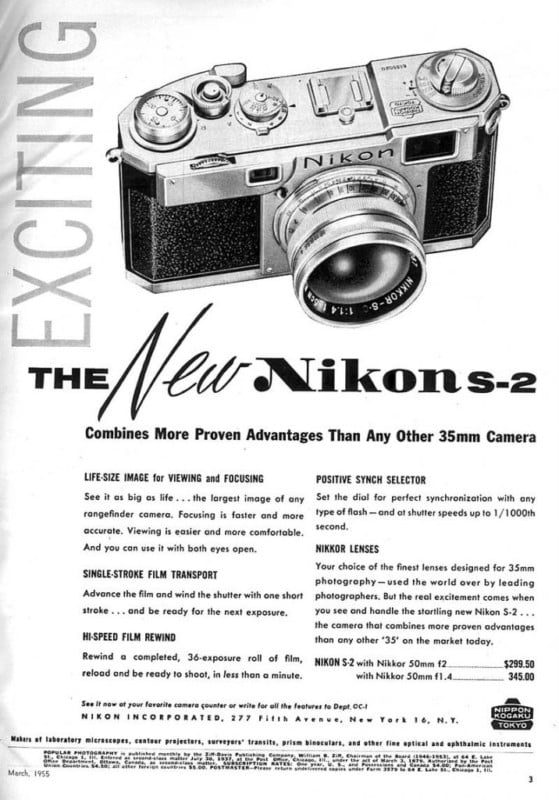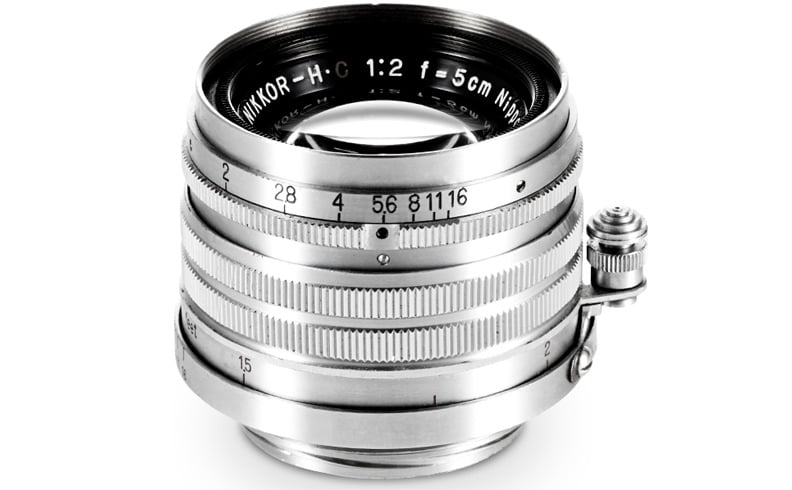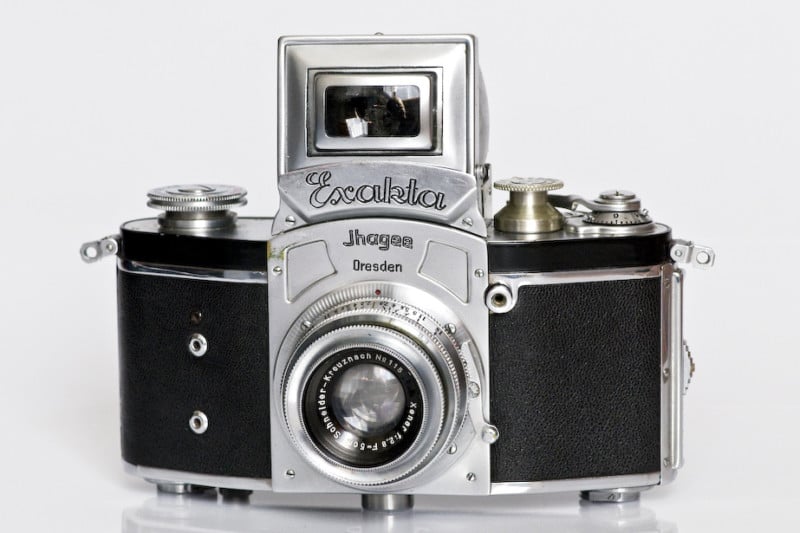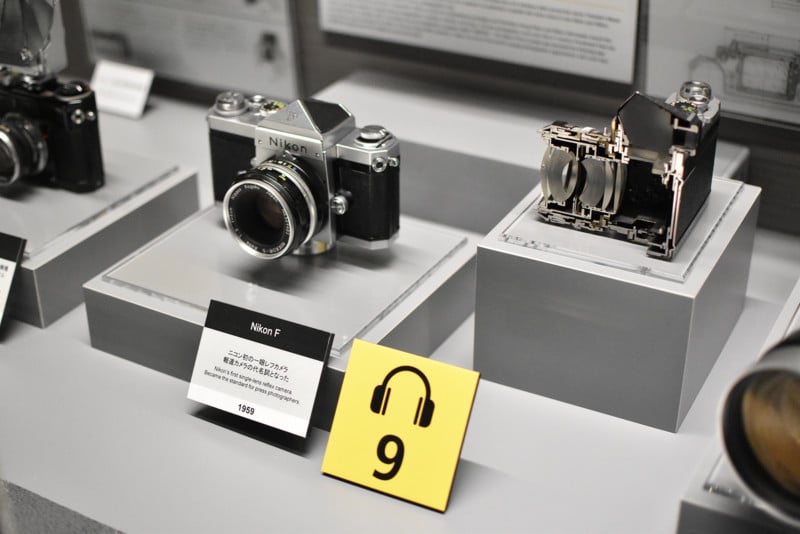![]()
As an art form and a technology, photography’s youth is only matched by its blisteringly rapid advancement. This creates something of a paradox for us as enthusiasts and professionals, where the history of the medium we so love can feel both short and overstuffed. Neither condition is conducive to any one camera gaining, let alone maintaining, a sense of permanence or constancy.
It can be easy to take for granted just how difficult it is for any camera to, well, be taken for granted. Yet here sits the Nikon F, over six decades since the initial release, as capable as ever, timeless like few others, and arguably the most important SLR in history.
It is remarkable, really, if you think about it. After all, Nikon did not invent the single-lens reflex camera with the F; in terms of next-level innovation, it holds no serious claim in any one area. So how? How did the Nikon F become the fixture, the staple, it is today? Was it merely a matter of good luck and savvy marketing, or was there something more? Let’s turn the clock back to before the camera’s March 1959 release.
Japan’s Foray Into Cameras

The Second World War was the fulcrum for all manner of technological advancement, and (as many of our history articles here at PetaPixel make clear) photography was no exception. This particular story is not one of military-fueled acceleration, however, but one of a war-battered crawl. In 1946, Japan was in ruin. The nation’s coffers were bare, and the United States’ decision to deploy the most horrendous weapon yet conceived by man against it — stripping two of its proudest cities from existence in a flash — threatened to leave Japan’s spirit as broken as its economy. Japan needed more than healing. It needed resurrection.
The government acted decisively through numerous government initiatives meant to supercharge the production of goods the world wanted, at a time when their national reputation was at its nadir. These initiatives were first targeted at companies that had succeeded as wartime manufacturers, including Nippon Kogaku K.K., the company that would eventually come to be known as Nikon.
![]()
Nippon Kogaku was perhaps the most ideal company the Japanese government could have boosted, given the circumstances. There was no better way to convince a leery world of the necessity of Japan’s exports than by providing products almost indistinguishable from their European rivals — except as good or even better and, most importantly, cheaper. Nippon Kogaku’s greatest skill was creating cameras like the Nikon S-series rangefinders: hybrid clones of the Contax and Leica M rangefinders, but with some improvements, including being arguably faster and certainly less expensive. Still, in a bitter sort of irony, it would take another war before the company truly began earning the respect it deserved.

In 1950, the Korean War began, sending photographers from across the world into East Asia. There, they found not only images of brutality, but impressive Japanese glass for their cameras. One such photographer was the prolific David Douglas Duncan, who found himself on assignment covering the conflict alongside Jun Miki for LIFE magazine. Miki requested Duncan take his photograph using his Nikkor lens. Duncan was so immediately impressed with the lens’s quality he sought a personal introduction to the manufacturer and subsequently secured Nikkor glass for every one of his Leica cameras. His photo-essay, “This is War!” is widely regarded as one of the most important and influential of all time for obvious socio-political reasons, but it contains one subtler, more undervalued impact: every shot was taken through a Nikon lens.

Nippon Kogaku had succeeded in the mission the country so needed. Its cameras and lenses were legitimized more on the world stage with each passing day. Adoption increased among the professional class. The company’s name showed up in print more frequently. It was not alone among Japanese companies in this climb — Canon, Chiyoda Kogaku (Minolta), Tanaka Kogaku, Nicca, and others were also making Leica M39 and Contax RF glass along with their own Leica and Contax-copy rangefinder bodies.
The same country so devastated by one war had been reinvigorated in no small part thanks to another. The Korean War had turned Japan’s occupiers into its greatest allies, and, crucially, consumers. “The same product, only better and cheaper” philosophy had worked, and now it was time for Japan, and Nippon Kogaku, to build something new.
The Rise of the SLR
One need not invent in order to innovate. Nippon Kogaku — whose “copycat” S-line of rangefinders were slowly gaining traction across the market — knew this better than most. To chart a new path and transform the company from the one chasing and improving the work of others into one others chased, Nippon Kogaku looked to an old idea that no one had yet gotten quite right: the single-lens reflex camera, more commonly referred to as the SLR.

One could trace the history of the SLR to the seventeenth century, to the use of a reflex mirror in a camera obscura, or to the late nineteenth century when the first SLR patent was granted. The release of the Kine Exakta in 1936, produced by Ihagee Kamerawerk in Germany, was the first SLR on the market. Behind the Exakta bayonet lens mount was the mirror box and shutter mechanism. The waist-level viewfinder was fixed, projecting a laterally reversed image — moving to the “left” of your viewfinder’s image meant you had to physically turn the camera right. This was not unusual — all medium format TLR (twin lens reflex) bodies before and after the Exakta operated in the same way, as did virtually any camera with a waist-level finder.
All of this hardly matters given that even twenty years after the introduction of the Kine Exakta, the SLR remained more conceptually intriguing than practically enticing. The trouble with SLRs of the time was numerous — they were mechanically complex with many finicky components, and they were physically larger and heavier with a much more limited lens selection. Prices were hardly competitive, too. However, they still had a major advantage over the popular rangefinders of the day: what you saw through the viewfinder of an SLR was an accurate representation of your frame, no matter the focal length or focus distance, though this was somewhat undercut in practical application by the fact that you were seeing the image laterally reversed.
No SLR had yet been built that could truly overtake the rangefinder, so Nippon Kogaku saw the opportunity to move beyond competing in an established market and begin leading in an emerging one.
Nikon Develops its First SLR: the Nikon F
In the autumn of 1956, development began on Nikon’s first SLR camera, the Nikon F. While the project was overseen by Masahiko Fuketa, the company’s head engineer, a bold step like this required an even bolder perspective. No one doubted Fuketa’s ability — he had overseen design on every camera the company had yet produced — but this task called for a radical, outside vision. The company did not need to look far.

Yusaku Kamekura was a graphic designer who had worked for Nippon Kogaku in the past, and his eye for branding and marketability brought a perspective vital to the company’s lofty goals. The value the company placed on this project was so immense, in fact, that the process was kept almost totally secret from not only the outside world but the company’s own executives. Fuketa and Kamekura found themselves virtually isolated, crammed into a tiny room within the factory, designing the future.
While the clandestine nature of the Nikon F’s development was no doubt guided first and foremost by a desire to guard corporate interests, it provided Kamekura unprecedented freedom of expression. There was no naysaying. No second-guessing. There was only Kamekura’s aesthetic prowess fused with Fuketa’s technical wizardry, chained together, finding their way to the perfect marriage of their genius. Kamekura decided early on to focus on a bold design featuring clean, straight lines. The concept was stunning. He envisioned the SLR, known for such numerous complications, as something beautifully simple, sleek, sharp, and, most crucially, modern.
Mechanically, Fuketa was on the same page, but practical realities stood in the way. He shared prototypes with Kamekura, outlining the development on the technical side, but Kamekura was not satisfied. While Fuketa was making great strides in simplifying the most onerous features of the SLR, in order to give the camera the components required to function, the cleanliness of the design would have to suffer. Of particular frustration were the elements protruding from the top of the camera, which disrupted the elegant lines Kamekura envisioned. Then, with a burst of inspiration no doubt spurred by the technical knowledge Fuketa instilled in him, the answer to Kamekura’s exterior obstacles became clear: the pentaprism.
The pentaprism had been one of the most monumental leaps forward in the race to produce a wide-use, popular SLR camera. All reflex cameras use a mirror placed at 45 degrees behind the lens, which projects the lens image onto a ground-glass screen viewed perpendicularly to the optical axis of the lens. Until the pentaprism, this projected a reversed image in the viewfinder — most of which were waist-level — limiting the comfort and usability of the camera. By internally reflecting the image multiple times, the viewfinder could finally work at a comfortable eye level and produce an image that was both vertically and laterally correct. The photographer could see the scene as it was before them — left was left, right was right, up was up… you get it.
![]()
Nikon did not invent this technology, nor was it the first to make use of it. Several others, notably Italy’s Rectaflex and Germany’s Contax S, had already begun implementing the pentaprism in their SLR cameras — both beating the Nikon F to market. So Kamekura’s inspiration was not one of invention, but rather of incorporation — why not design the top of the camera to feature a housing for the elements that disrupted the pure lines he envisioned, and why not give that housing the signature shape of this remarkable advancement? Why not model the housing after the pentaprism itself?
In every way, this idea was a success. The aesthetic concerns were not only alleviated but a marketing signature was born. It was brilliant. Of course, the pentaprism was not the simplest shape to manufacture at the time. Time and time again, machining the piece was a failure. It would emerge with holes, inconsistent, broken, misshapen. Fuketa pressed Kamekura to consider an alteration: cut the intersection point at the top, leave an open hole. Then, the pieces could be fused from rectangular elements. Kamekura refused to back down. He was no prima donna, and he deeply respected the need for a design to be functional and reproducible, but this shape was too integral to give up on. After multiple trials, the problem was solved — the Nikon F’s design was locked and flawless.
Mechanically, Fuketa had his own dragons to slay. Under his passionate leadership, his team conceived of a host of new features, each one chipping away at the gap between rangefinder and SLR even more. By the time they were done, the Nikon F boasted a set of true advancements, including a new instant mirror return mechanism, interchangeable viewfinders and focusing screens, and an impressive auto-diaphragm stop-down mechanism for open-aperture focusing and depth of field preview. Fuketa’s craftsmanship had paired with Kamekura’s artistry to create more than a great camera. They had created a camera with the potential to upend the entire market.
Lasting Impact
No matter how impressive this camera may have been, the goals of Nippon Kogaku, and those of Japan itself, were still extremely high, and extremely personal. Making a splash is one thing, but Japan had fought its way back from utter ruin to become a true world power with one of the fastest-growing economies on earth, a more liberal society, and a partner to the same Western democracies that they had had so bitterly fought against. Japan had shown the world it could rebuild more successfully and efficiently than anyone had imagined. It had shown the world it could innovate. What it needed to show now was that it could dominate. Nippon Kogaku’s products had to do more than excite, more than even advance. It had to be trusted. It had to last.
![]()
The company met this challenge through two key steps. The first was through some of the most aggressive and exhaustive testing and benchmarking any camera had ever seen. Could the camera survive an earthquake? A lightning strike? The arctic cold? How many shutter actuations before it failed? 25,000? 50,000? No, it had to be 100,000. Through challenge after challenge, the team exhausted themselves to provide Kamekura’s elegance and Fuketa’s ingenuity another ingredient they deserved: reliability. And they succeeded.
The Birth of a Camera System
The final step Nippon Kogaku took to ensure the staying power of the Nikon F was to make it more than a single, bold new camera: it made it a bold new camera system. An entire set of new lenses designed to work with the fresh new mount and the auto-aperture system were devised. In the face of this heretofore unheard-of level of interchangeability, the rangefinder was sure to be toast.
Gone would be the days of matching lenses to the camera’s frame lines or the need for external viewfinders for wide lenses. Gone were the days of inaccurate framing, parallax compensation issues, or lengthy minimum focus distances. Previewing depth of field in the viewfinder? No problem. The ability to use zoom lenses? Not an issue. Accurately frame and focus wide open at 135mm, 200mm, or even longer? Sure.
![]()
In 1959, the F made its first appearance on the world stage and the response was immediate. Nippon Kogaku had done it. This was a marvel, a game-changer, a breakthrough, a landmark. It was revolutionary. We hear these types of words bandied about every day on photography sites and forums and comment sections, and we get excited, but it makes it difficult to truly comprehend the totality of what a truly revolutionary product is.
Most often, it is not the brand new thing, but the thing that does the brand new thing so well we forget the brand new thing was ever brand new at all. That was the Nikon F. It is the camera that first saw the top of Everest. It was the first 35mm camera to go to the Moon and come aboard NASA’s Skylab. It was the first SLR to see common (and very popular) use in war.
Revolutionary and Timeless

Born of the pain of the past, the competence of the present, and the desperate need for a secure future, there is no wonder it is timeless. A country decimated to ruin by western adversaries pulled themselves out of the rubble, rebuilt as no one had seen, and set its sights on global economic conquest. And they succeeded.

While the SLR is almost certain to go the way of the dodo due to the emergence of the latest technology — digital mirrorless — the Nikon F will forever remain a timeless piece of history that molded the history of the photographic world.
Image credits: Header photo by Dnalor 01, Creative Commons.
Author: Matt Williams
Source: Petapixel



